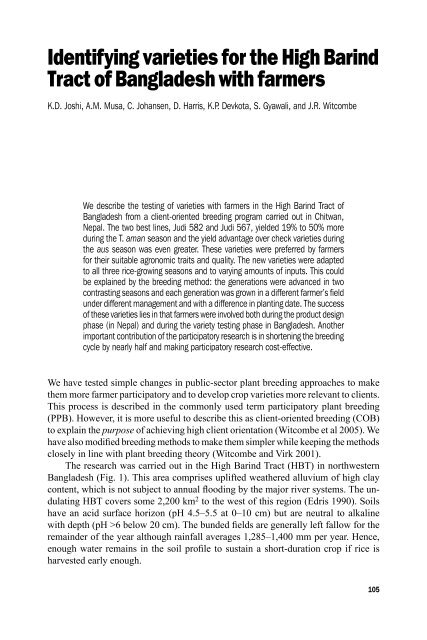Download (2461kB) - University of Greenwich
Download (2461kB) - University of Greenwich
Download (2461kB) - University of Greenwich
- No tags were found...
You also want an ePaper? Increase the reach of your titles
YUMPU automatically turns print PDFs into web optimized ePapers that Google loves.
Identifying varieties for the High BarindTract <strong>of</strong> Bangladesh with farmersK.D. Joshi, A.M. Musa, C. Johansen, D. Harris, K.P. Devkota, S. Gyawali, and J.R. WitcombeWe describe the testing <strong>of</strong> varieties with farmers in the High Barind Tract <strong>of</strong>Bangladesh from a client-oriented breeding program carried out in Chitwan,Nepal. The two best lines, Judi 582 and Judi 567, yielded 19% to 50% moreduring the T. aman season and the yield advantage over check varieties duringthe aus season was even greater. These varieties were preferred by farmersfor their suitable agronomic traits and quality. The new varieties were adaptedto all three rice-growing seasons and to varying amounts <strong>of</strong> inputs. This couldbe explained by the breeding method: the generations were advanced in twocontrasting seasons and each generation was grown in a different farmer’s fieldunder different management and with a difference in planting date. The success<strong>of</strong> these varieties lies in that farmers were involved both during the product designphase (in Nepal) and during the variety testing phase in Bangladesh. Anotherimportant contribution <strong>of</strong> the participatory research is in shortening the breedingcycle by nearly half and making participatory research cost-effective.We have tested simple changes in public-sector plant breeding approaches to makethem more farmer participatory and to develop crop varieties more relevant to clients.This process is described in the commonly used term participatory plant breeding(PPB). However, it is more useful to describe this as client-oriented breeding (COB)to explain the purpose <strong>of</strong> achieving high client orientation (Witcombe et al 2005). Wehave also modified breeding methods to make them simpler while keeping the methodsclosely in line with plant breeding theory (Witcombe and Virk 2001).The research was carried out in the High Barind Tract (HBT) in northwesternBangladesh (Fig. 1). This area comprises uplifted weathered alluvium <strong>of</strong> high claycontent, which is not subject to annual flooding by the major river systems. The undulatingHBT covers some 2,200 km 2 to the west <strong>of</strong> this region (Edris 1990). Soilshave an acid surface horizon (pH 4.5–5.5 at 0–10 cm) but are neutral to alkalinewith depth (pH >6 below 20 cm). The bunded fields are generally left fallow for theremainder <strong>of</strong> the year although rainfall averages 1,285–1,400 mm per year. Hence,enough water remains in the soil pr<strong>of</strong>ile to sustain a short-duration crop if rice isharvested early enough.105
















